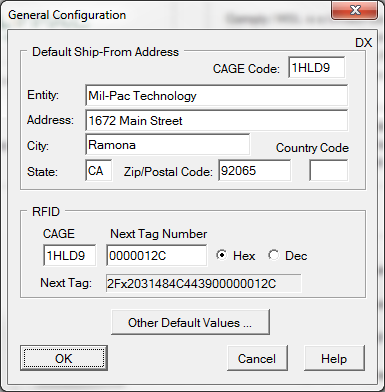Default Ship From
The Default Ship-From Address is used to populate new shipments, primarily for the Military Shipment Label (MSL) but also for generic address label formats. Addresses should fit within the width restriction of 35 characters for MSLs. The combination of City, ST Zip must also fit within that limit.
The Country Code is optional for United States (US) addresses. A reference table of other country codes is available on the MSL address entry screens.
RFID Settings
RFID tags are composed of two identifiers that must be established before generating any RFID labels.
•Sequence Number - a number that is sequentially allocated to create a unique identifier
•CAGE Code - which is included to make an RFID sequence globally unique
The CAGE and Next Tag Number are combined to create Radio Frequency Identifier (RFID) tags that are allocated by Labeling when printing RFID-enabled label formats. The sequence portion of the RFID is a nine-digit hexadecimal number (base 16). Leading zeroes are not required. The ID many also be entered in decimal (base 10) format, should that be more convenient for you. The use of hexadecimal by DOD allows for more IDs to be encoded with just the nine characters available. In fact, a total 68,719,476,736 unique IDs can be encoded with nine hex digits.
Let's say that you want to start with tag number 1,000,001. Click on Dec and then enter that as the Next Tag Number. Then click on Hex and you will see that it has been converted to 0000F4241 and that the Next Tag is 2Fx2031484C440000F4241.
You can also use the Dec button to convert an RFID tag number into its decimal equivalent. You could click on Hex and then enter 12C and then Dec to find out that tag number 00000012C is the 300th tag. When entering hex tag numbers, leading zeroes are not required.
CAGE Code and 2Fx20
The CAGE is also encoded in hex, but in a special way. In the example, "1HLD9" is encoded as "2031484C4439". RFID tags will always start with "2F" and either a zero, one or two, depending on whether the tag is for a pallet, case or unit container. The 20 following that is actually a leading space for the CAGE code that would allow for DODAACs to be encoded.
Limitations
MIL-Comply has a limitation of 8 characters for the tag sequence, so the highest tag that can be encoded is 0FFFFFFFF, or 4,294,967,295 unique tags. The user interface described above will currently only calculate as far as 07FFFFFFF, or 2,147,483,647.
Other Default Values
The Other Default Values represent fields used mostly for DD250s, so they may be useful if shipments created in Labeling are also used to submit Receiving Reports to WAWF.
